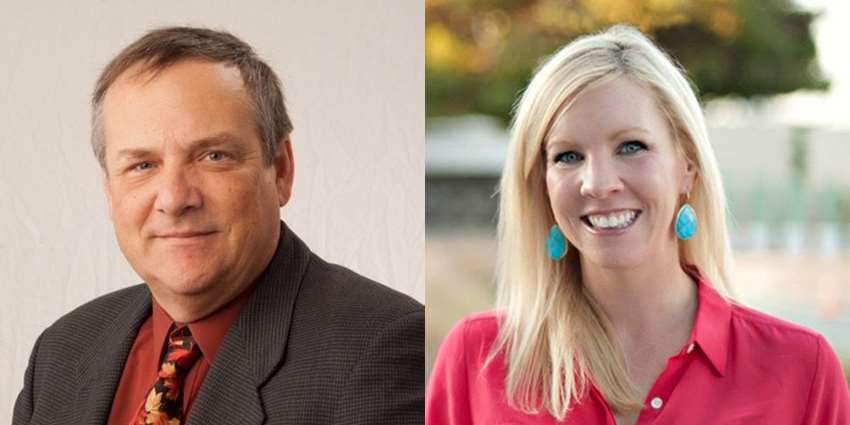More than 150 participants from 13 states and South Africa attended the recent Southern Region Water Conference, “Improving Adoption of Sustainable Water Management Practices,” hosted by the Texas A&M AgriLife Extension Service in College Station.
The conference, co-hosted by the Texas Water Resources Institute, provided three days of workshops, posters, tours and speakers discussing optimizing water-use efficiency and protecting water quality in the Southern United States.
“The conference was a chance to learn about what is going on in other states in the region to improve adoption of successful water management practices,” said Dr. Diane Boellstorff, AgriLife Extension water resources specialist and associate professor in Texas A&M University’s Department of Soil and Crop Sciences.
Keynote speaker and Texas State Climatologist John Nielsen-Gammon gave an overview of the climate outlook for the southern region of the United States to the audience of farmers, ranchers, agricultural professionals, researchers, agency representatives and students.
“The overall increase of rain in the Southern United States is about 10% per century, which is fairly high,” said Nielsen-Gammon, Regents Professor of Atmospheric Sciences at Texas A&M. “It's increasing across most of the Southern United States, but the biggest rates of increase are in Texas, Oklahoma, Louisiana and Arkansas.”
He said the intensity of rainfall is increasing faster than the total amount of rainfall.
“If you think of the consequences of that, it's going to impact the amount of water that goes into infiltration that is immediately available in the soil and recharging aquifers versus the amount of water that runs off into rivers, streams, riparian systems and supplying water to reservoirs,” he said.
Once it has rained, or flooded, Nielsen-Gammon said climate affects what the atmosphere is taking away from the land surface. “If you get higher temperatures, you have greater evaporation,” he said, reporting that temperatures have increased about 3 degrees Fahrenheit since 1975.
However, Nielsen-Gammon said there's a lot of other things that are going to affect evaporation.
“For example, more carbon dioxide actually cuts down on the amount of transpiration from plants,” he said. “That means they don't need to lose as much water vapor into the atmosphere and consequently, they're not going to be depleting water from the soil as rapidly.”
Nielsen-Gammon said hotter temperatures are a side effect of plants producing less transpiration. “Temperatures are increasing and are projected to increase faster over land than over water because the plant cover isn't going to be as robustly pumping water into the atmosphere as it used to be.
“While the plants will be doing a better job of keeping water in the ground, reservoirs will be doing a worse job,” he said. Because evaporation will be more robust with hotter temperatures, evaporation will occur from streams, bays and estuaries, causing reduced inflow.
“Unfortunately, with each location in each situation, there's a different answer to what we expect will happen with climate and its consequences for water use and water demand,” he said.
As the second keynote, Brooke Paup, Texas Water Development Board (TWDB) member, said Texas is growing at an extremely rapid pace, adding that the Texas Comptroller’s office estimates that the state is growing by almost 1,200 people a day. This growth is putting strain on the state’s resources, including its water infrastructure.
Because agricultural irrigation accounts for 55% of the state’s annual water use, Paup said agricultural water conservation is “incredibly important,” and irrigation conservation is the least costly water management strategy, costing $147 per acre-feet.
According to the 2017 state water plan, Paup said the demands for irrigation in 2020 are projected to be 9.4 million acre-feet, with existing supplies at 6.1 million acre-feet. The needs, or potential shortages, for irrigation in particular are projected to be 3.5 million acre-feet. Strategies for more supplies will provide less than a million acre-feet, leaving a deficit of 2.5 million acre-feet.
“That's really a deficit,” she said. “That's why every single drop counts. There's no Texas miracle without water. We need every single drop.”
Paup said, however, the water demand for irrigation is projected to decline by almost 2 million acre-feet by 2070, according to long-term projections in the plan.
“That's a tribute to most of you in this room today for the ingenuity and stewardship of the people who are actually working on conservation methods,” she said.
Paup said the recent Texas Legislature passed a bill that increased TWDB’s agricultural conservation loan program from $600,000 per year to over $1.2 million available annually.
“That is the Legislature realizing that the ag community needs more resources for water conservation,” she said. “This means that the projects we can fund can be larger than what we've done in the past, and we can fund more so we can get more grant dollars out to help the rural communities.”
In addition to the keynote addresses, concurrent workshop sessions were held so attendees could hear of ongoing programs in various water areas and solicit input on their own efforts. Workshop topics included:
- Irrigation water management.
- Urban water conservation.
- Water considerations around the home, including private water well management, protecting drinking water supplies, turf management, irrigation and rainwater harvesting.
- Watershed management.
- Programs/incentives for growers, including new farm bill programs, U.S. Department of Agriculture’s Natural Resources Conservation Service programs and Sustainable Agriculture Research and Education (SARE) opportunities.
The conference was a collaboration between SARE, AgriLife Extension, Texas Water Resources Institute and others, including the cooperative extension programs of Prairie View A&M University, Oklahoma Water Resources Center, Mississippi State University, North Carolina State University, University of Florida, University of Georgia, Louisiana State University AgCenter, University of Kentucky, Clemson University and Auburn University.
The conference was supported in part by the U.S. Department of Agriculture National Institute of Food and Agriculture under award number LS18-288 through the Southern Sustainable Agriculture Research and Education program.



